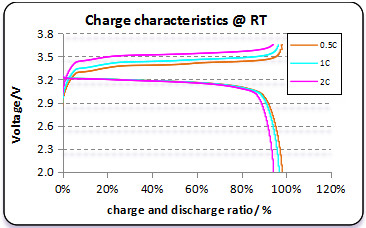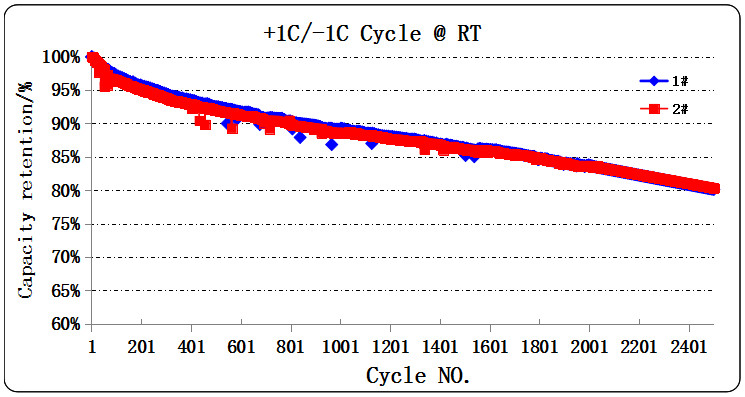Shenzhen Topband Battery Co., Ltd |
|
Low Self-discharge 3.2V50Ah Rechargeable Lifepo4 Battery with 2 Years Warranty and TUV/ UN38.3
1. About us
Shenzhen Topband Battery Co., Ltd, a company professional to do LiFePO4 battery, which is founded in 1996 and listed in Shenzhen in 2007.There are over 300 R&D engineers and about 3,000 employees in the 70,000 square meters Topband industrial park.We can provide One-Stop Solution of new energy, from cell, BMS/PCM to battery pack assembling.
2. General
This product specification describes the technique standards,test methods and precaution notes of prismatic type( Lithium ion) LiFePO4 rechargeable cell,manufactured by Shenzhen Topband Battery Co.,Ltd.
3. Specification
| No. | item | standard | remark | ||
| 3.1 | Nominal capacity | 50Ah |
RT,0.5C | ||
| 3.2 | Min capacity | 49.5Ah | |||
| 3.3 | Internal impedance | ≤1.5mΩ | RT,1000Hz | ||
| 3.4 | Nominal voltage | 3.2V | |||
| 3.5 | Weight | 1350±50g | |||
| 3.6 | Voltage range | 3.65~2.00V | |||
| 3.7 | Recommended charge current | ≤1.0C | |||
| 3.8 | Recommended discharge current | ≤1.0C | |||
| 3.9 | Max continuous charge current | 2C | RT | ||
| 3.10 | Max continuous discharge current | 3C | RT | ||
| 3.11 | Max pulse discharge current | 5C | RT,10s,SOC≥20% | ||
| 3.12 | Cycle life | 2000 cycles capacity retention≥80% | RT,1C,100%DOD | ||
| 3.13 | Charging temperature | 0~45℃ | |||
| 3.14 | Discharging temperature | -20~55℃ | |||
| 3.15 | Storage temperature | -10~30℃ | |||
| 3.16 | Terminal torsion | ≤5.5N·m | |||
| 3.17 | Appearance | No break,scratch,distortion,contamination,leakage. | |||
4. Test Condition
4.1 Standard Test Conditions
All tests are conducted at temperature 25±2℃, humidity was 15%~90%RH, atmospheric pressure at 86~106kPa.
Unless there are other special instructions, all performance was tested with unused cells within 1 month after production date.
4.2 Standard Charge Method
The "Standard Charge" means in an ambient temperature of 25±2℃,the cell was discharged with 0.5C constant current to cut-off voltage 2.0V,standing 1hour.Then charged it with 0.5C constant current to 3.65V,then change into constant charge mode,until the charging current down to0.05C,then stop charging and standing 1h.
5. Electrical Characteristic
| No. |
Item |
Test method |
Criteria |
| 5.1 |
High Temperature Discharge Performance | The cell was charged in accordance with 4.2,and stored in an ambient temperature of 55±2℃ for 5h,then discharged to 2.0V with 1C constant current.After that,then place the cell in the ambient temperature of 25±2℃ for 4h then check its appearance. | 1,Retention capacity at 55℃ ≥95% 2,No deformation, No crack. |
| 5.2 |
Low Temperature Discharge Performance | The cell was charged in accordance with 4.2,and stored in an ambient temperature of -20±2℃ for 24h,then discharged to 1.8V with 1C constant current.After that, place it in the ambient temperature of 25±2℃ for 4h, then check its appearance. | 1,Retention capacity at -20℃ ≥70% 2,No deformation, No crack. |
| 5.3 |
Rate Charge Performance in Normal Temperature | Under the ambient temperature of 25±2℃
|
Capacity retention≥80% |
| 5.4 | Rate Discharge Performance in Normal Temperature |
The cell was charged in accordance with 4.2,then discharge to 2.0V with 3C current in an ambient temperature of 25±2℃. |
Capacity retention≥95% |
| 5.5 |
Charge Retention |
The cell was charged in accordance with 4.2,and stored in an ambient temperature of 25±2℃ for 28 days,and then discharged to 2.0V with 1C constant current. | Capacity retention ≥85% Capacity recovery ≥90% |
| 5.6 |
Cycle Life (25±2℃) | The cell was charged to 3.65V with 1C CC/CV cut off 0.05C,stayed for 30min;Subsequently,the cell was discharged to 2.0V with constant current 1C,and stayed for 30min;Prior to next charge-discharge cycle.Record all the cycles until the retention capacity<80%. |
≥2000cycles |
6.The Performance Test Curve
The capacity retention at different discharge rate

The capacity retention at different charge rate
The dischcarge capacity retention at different temperature

The capacity retention at different cycles

7. Our Service
For safety assurance, please discuss with Shenzhen Topband Battery Co.,Ltd in advance for your equipment design, the circuit protection of battery/cells, high rate discharge, rapid charge and other aspects of special application.